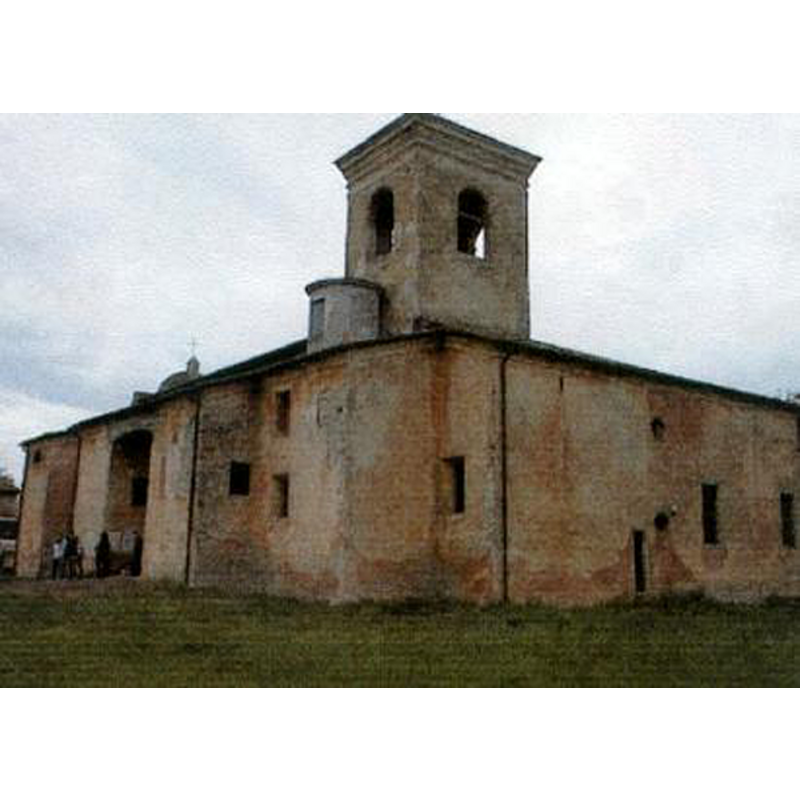San Polo d'Enza / Caviano / Cavigliano / Caviliano / Cavilianum / Cavilianvmia]
![Main image for San Polo d'Enza / Caviano / Cavigliano / Caviliano / Cavilianum / Cavilianvmia]](/static-50478a99ec6f36a15d6234548c59f63da52304e5/compressed/1141129006_compressed.png)
Image copyright © Alessandro Garbasi, 2014
CC-BY-SA-3.0
Results: 8 records
Apostle or saint - Evangelists - St. Mark - symbol - winged lion - with book
New Testament - public life of Christ - baptism of Christ - in the Jordan - John the Baptist holding his right hand on Christ's head
Scene Description: [cf. FontNotes]
Copyright Statement: Image copyright © www.itgsecchi.it, 2014
Image Source: [www.itgsecchi.it/archivio progetti/pellegrinimedioevo/pellegrini/htm/LA PIEVE DI CAVILIANO.htg] [accessed 29 November 2014]
Copyright Instructions: No known copyright restriction – Fair Dealing
animal - reptile - snake - coiled
design element - motifs - floral - rosette - 6-petal
design element - motifs - vine
symbol - cross - Greek - Maltese
view of church exterior
INFORMATION
FontID: 19540CAV
Object Type: Baptismal Font1
Museum and Inventory Number: Gliptoteca dei Musei Civici, in Reggio Emilia
Church/Chapel: Pieve di San Pietro [aka San Polo / San Pauli di Caviliano]
Church Patron Saints: St. Peter? [originally dedicated to St. Peter, St. Paul and St. Mary]
Country Name: Italy
Location: Reggio Emilia, Emilia-Romagna
Directions to Site: Located NNW of Canossa, 18 km SW of Reggio Emilia, 70 km W of Bologna; the church is located about 1 km N of the village
Font Location in Church: [in a museum]
Century and Period: 11th - 12th century, Romanesque
Workshop/Group/Artisan: Evangelists' font?
Cognate Fonts: [cf. FontNotes]
Credit and Acknowledgements: We are grateful to Alessandro Garbasi for his information on, and images of this font
Church Notes: Tiraboschi (1824) notes a church here consecrated by bishop Adelberio (1140-1163) ca. mid-11thC
Font Notes:
Click to view
Studied and illustrated in Garbasi [www.vallideltermina.it/Pag_Pub_Mp_Nr_35_2.html] [accessed 29 November 2014] as a tub-shaped, almost cylindrical, baptismal font the sides of which are totally covered in carvings which, unfortunately, are much worn now due to exposure to the elements, that have seriously damaged the object; Garbasi (ibid.) describes the ornamentation of the font as being divided into two registers below a moulded upper rim; in the centre of the upper register is a scene that includes a standing figure with another below of which only the head is visible; then, clockwise, a large cross, a reptilian beast with a winged griffin and a lonely leaf from a no longer extant vine; the next area of the upper register is very damaged and the details of the carving hardly discernible: an unidentified animal, a male figure with a triangular face appears to have been holding an open book in his hands, a winged lion with an open book in its front paws, a bull identified by its horns, and an eagle with a book, therefore making a grouping of the symbols of the four Evangelists; Garbasi (ibid.) further notes two rosettes, one between the bull and the lion, the second up higher, to the side of John's symbol. Regarding the much damaged central scene, Garbasi suggests it can be identified as the Baptism of Christ in the Jordan, and notes the position of the Baptist's hand as being similar to that found on the Swedish font at Bjäresjö; the lower register is decorated with a large foliated vine. With regards the large cross on this font, Garbasi (ibid.) suggests it represents a processional cross, not unlike those on the Italian fonts at Chiavenna and Vicofertile, and the one on the English font at Eardisley, from the same Herefordshire master or workshop that produced the font at Castle Frome. Garbasi (ibid.) suggests the faint possibility that the presence of a rosette by the baptismal scene may suggest the parallel the presence of the Holy Ghost symbol, the dove, as it appears in the Swedish fonts of Bjäresjö and Grötlingbo. Garbasi (ibid.) relates the presence of the Evangelists' symbols on fonts referring to those at the mid-11th century font at Biscegle, on the aforemention one at Castle Frome, and on the French font at Mauriac, and adds that the only other baptismal font of the period in northern Italy to include symbols of the Evangelists -though only three- is the font at nearby Canossa. Garbasi (ibid.), however, states that the similarities between these two fonts are countered by the obvious differences, and suggests foreign examples, like the one at Brackley, Northamptonshire, with its two registers and the vigorous vine running around the lower part, all of which leads Garbasi to suggest a Longobard pedigree to the font at Caviano, in a treatment and imagery closer to the English and wider Nordic models; he suggests a date for this font between the mid-11th and the mid-12th century, most likely in the early-12th century. Noted and illustrated in [www.itgsecchi.it/archivio progetti/pellegrinimedioevo/pellegrini/htm/LA PIEVE DI CAVILIANO.htm] [accessed 29 November 2014] as a baptismal font of this church [now in the Gliptoteca dei Musei Civici, in Reggio Emilia], somewhat similar to the church of the monastery (abbey) of S. Apollonio, Canossa [itself in the museum of the Castello di Canossa -- cf. Index entry].
COORDINATES
UTM: 32T 613687 4943219
MEDIUM AND MEASUREMENTS
Material: stone, sandstone
Font Shape: tub-shaped
Basin Interior Shape: round
Basin Exterior Shape: round
Drainage Notes: no lining
Rim Thickness: 14.5 [calculated]
Diameter (inside rim): 90-91 cm*
Diameter (includes rim): 119-120 cm*
Basin Depth: 55-56 cm*
Basin Total Height: 82 cm*
Font Height (less Plinth): 82 cm*
Notes on Measurements: * Garbasi [op. cit.]
LID INFORMATION
Notes: holes in basin rim suggest anchorage for old cover
REFERENCES
Tiraboschi, Girolamo, abate, Dizionario Topografico-Storico degli Estati Estensi [opera postuma], Modena: Tipografia camerale, 1824

![[cf. FontNotes]](/static-50478a99ec6f36a15d6234548c59f63da52304e5/compressed/1141129004_compressed.png)

